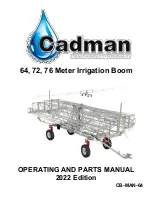
─ 30 ─
Error
Code
LED1
(green)
LED2
(red)
Symptom
Cause
Corrective action
4116
2
blinks
Abnormal
rotation of the
exhaust fan
motor
(Centrifugal fan
does not work,
insufficient
motor speed,
excessive
motor speed,
or rotation
detected when
operation is
stopped)
Faulty connection of the exhaust fan
motor connector (CN9) on the power
circuit board
Check the connector (CN9)
connection.
Faulty connection of the connectors
(CN14 - CN114 and CN19 - CN119)
between the control circuit board and
power circuit board
Check the connector connections
(CN14 - CN114 and CN19 - CN119).
The model selection switch (SW6) is
not set correctly.
Make the SW6 setting appropriate
for the model.
(See Chapter 7. (9) Setting status
record (page 47).)
The temperature around the product
is high.
Use the product at a temperature
of 40°C or lower.
The motor and centrifugal fan are not
fixed securely.
Check the installation state of the
motor and centrifugal fan, and fix
them securely.
Deformed centrifugal fan
Replace the centrifugal fan.
Foreign objects around the centrifu-
gal fan
Check the air course and around
the centrifugal fan, and remove
any foreign matter.
Fan motor failure
Replace the fan motor.
(See page 16.)
Circuit board failure
Replace the power circuit board.
When operation is stopped, the
exhaust fan rotates due to outside
wind.
Prevent the outside wind from
intruding.
5101
4
blinks
Outdoor air
(OA) thermis-
tor related
error
Faulty connection of the thermistor
connector (CN7) on the control cir-
cuit board
Check the connector (CN7)
connection.
Thermistor failure
Disconnect the connector (CN7),
and check the resistance of the
thermistor.
If the equivalent thermistor resis-
tance differs greatly from the
ambient temperatures, replace the
thermistor.
(See (5) Temperatures and therm-
istor resistance table (page 34).)
5102
5
blinks
Return air
(RA) thermis-
tor related
error
Faulty connection of the thermistor
connector (CN5) on the control cir-
cuit board
Check the connector (CN5)
connection.
Thermistor failure
Disconnect the connector (CN5),
and check the resistance of the
thermistor.
If the equivalent thermistor resis-
tance differs greatly from the
ambient temperatures, replace the
thermistor. (See (5) Temperatures
and thermistor resistance table
(page 34).)
















































